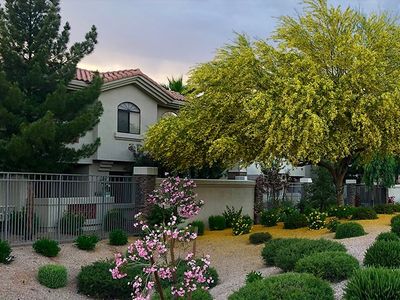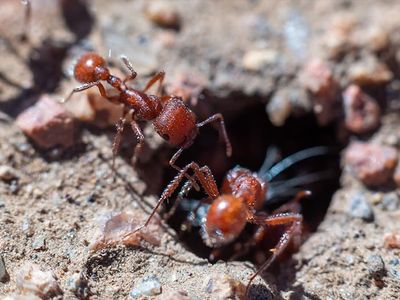What do harvester ants look like?
There are 22 species of harvester ants in the United States, and they vary in appearance. They range from ¼ to ½ an inch. They may appear reddish to dark brown and may have abdomens that are darker or black. If you're looking to identify these ants, you'll need more than color and size, as other ants share these physical traits. Look for the large, broad, and blocky head to help you with this identification.

Why are they called harvester ants?
These ants are known for their propensity to harvest seeds and store them as a primary source of food. They use the seeds for more than food. They're able to draw moisture out of the seeds to meet all of their moisture requirements. Workers bring the seeds deep into the ground where the nest is protected from the hot and dry Arizona sun, and where appropriate moisture levels are maintained.
Do harvester ants bite or sting?
Yes, these ants can deliver a painful sting. While often confused for fire ants, harvester ants are more venomous. They're known to take down animals in the wild. Some harvester ant species have a barbed stinger, similar to honeybees. Unlike honeybees, they rarely die after stinging, and are able to sting multiple times. Fortunately, they aren't prone to sting when away from their nests. If you have one of these ants crawling on you in your backyard, you're not likely to get stung. But take precautions around areas where their nests are hidden under the ground. You can detect nests by a 3 to 6-foot lack of vegetation and pebbles on the bare ground around the entrance to the nest.
Are harvester ants dangerous?
These ants are potentially dangerous as they are venomous insects that have a potent venom. But the greater threat is that they can cause an allergic reaction. Symptoms associated with an allergic reaction to a harvester ant sting are sneezing, labored breathing, wheezing, swelling, dizziness, tightness in the chest, hives, diarrhea, nausea, vomiting, and worse. Serious reactions can lead to fainting, shock, or coma.
What are the signs of a harvester ant infestation?
If you find bare patches and pebbles and small soil mounds, you have harvester ant activity in your yard. If you see workers indoors, it is a warning that you have a nest near your exterior walls. You may also see worker ant activity both indoors and outdoors because harvester ants are generally active during the daytime.
Where do harvester ants nest?
You're most likely to find a harvester ant nest in a sunny location, and where the soil is ideal for easily creating tunnels and galleries in the ground. They can also create nests near gardens and general vegetation where seeds are acquired.
Why do I have a harvester ant problem?
When these ants find ideal conditions for habitation, they move in. They are primarily motivated by soil type, preferring a property that has grainy soil that is easy to excavate. If you have well-drained, sandy, or loamy soil, these ants may take notice.
How do I get rid of harvester ants?
When you see these ants in your home, it is likely that they're coming from an outdoor nest. Professionals track ant routes and target the nests with control materials that break the life cycle and eliminate the colonies. Along with this, professionals work to address the conditions that allowed for the infestation, such as patching entry points and performing a pest treatment to the exterior of your home to keep ants out.
How do I keep harvester ants away?
There is no effective method to naturally deter harvester ants and keep them away from your property. Contact the Greenway Pest Solutions team for the strategic application of control materials to eliminate colonies and manage where these ants are allowed to explore on your Arizona property.








